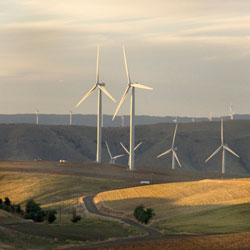 For years, wind developers seeking to build projects in areas new to wind development were frequently advised to keep a low profile. In essence, the quieter, the better. This often limited the amount of project-related information available to the public and community leaders, and minimized stakeholder engagement.
For years, wind developers seeking to build projects in areas new to wind development were frequently advised to keep a low profile. In essence, the quieter, the better. This often limited the amount of project-related information available to the public and community leaders, and minimized stakeholder engagement.
According to David Friend, CEO of U.S. Wind Force, such conventional thinking went something like, ‘Anything you say can and will be used against you by any project opponents.’
However, that mind-set is antiquated, says Friend, whose company is developing the 55.2 MW Pinnacle Wind Farm at NewPage, located in Mineral County, W. Va.
‘You can try to fly below the radar, but that doesn't work anymore,’ he explains, adding that the old way of staying quiet typically gave the illusion that there was something to hide or that a wind project was not publicly supported.
Pinnacle, which features Mitsubishi 2.4 MW wind turbines, was developed jointly by U.S. Wind Force and Edison Mission Energy, which acquired the project earlier this year. Friend says turbine erection at the site is under way and remains on track for commercial operation by the end of the year.
Since U.S. Wind Force started work on Pinnacle in 2009, the developer has put a premium on community outreach, and such efforts have made all the difference, Friend says.
To that end, U.S. Wind Force formed a community advisory panel (CAP), comprising 20 community leaders, including citizens who opposed the project. To date, there have been 32 meetings and four open houses to highlight the many environmental and economic benefits of the project.
For example, the wind farm is expected to reduce carbon emissions by 128,625 tons annually. The wind farm's nameplate capacity also equates to 87,000 tons of coal required per year for same amount of energy production. In addition, the county will collect an estimated $433,000 in annual average property taxes, as well as additional taxes to local, state and federal entities.
A charitable community benefit fund set up by the developer will also benefit the local community.
‘At the open houses, we had experts available to anyone asking questions,’ Friend says, adding that such full disclosure provides ‘an opportunity to dispel myths.’
Other cooperative efforts surrounding the wind project involved altering turbine delivery so that their arrival would not interfere with the community's back-to-school schedules.
‘One of the concerns that came out of discussions with the advisory panel was a concern around school-bus schedules and safety,’ he says. ‘People were concerned that turbine delivery would interfere with bus schedules, and parents were concerned that turbine delivery would delay their arrival at home or at school or that of a caregiver that needed to meet them."
Friend says he made an arrangement with the local administration for turbine delivery not to coincide with school-bus activity. However, it was not always evident that the developer's openness about the project would have benefits.
‘There was a great deal of trepidation on our part,’ he explains. ‘We knew it would be a lot of work and expense, and that anything we said could potentially be used against us,’ he says. ‘But, most of the time, the information that's put out by opponents is inaccurate. Ultimately, it's better that we control the message.’



